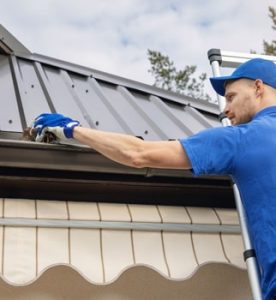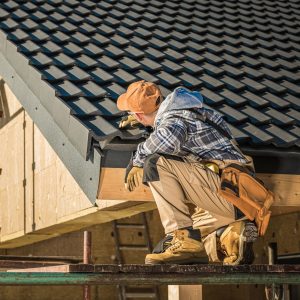You must take care of your roof and gutters if you’re a homeowner. Not only can this help protect your home from weather damage, but it can also prevent costly repairs down the road. In this blog post, we’ll discuss the different types of damage that can occur to your roof and gutters and the steps you need to take to prevent them from happening. We will also provide tips on inspecting and maintaining your roof and gutters so that they stay in top condition for years to come.
What are the benefits of having a good roof and gutters?
Roofing and gutters are essential for protecting your home from harsh elements. A well-maintained roof and gutters can help to reduce air pollution, rainwater infiltration, and water damage. Furthermore, they can also improve the thermal insulation of your home and act as a natural roofing material. You can also save money on your energy bill by installing solar-powered roofs or seamless gutters. Regular maintenance and repairs can help to keep your roof and gutters in great condition for years to come. If you are experiencing any roofing or gutter issues, consult a professional roofing contractor. A qualified contractor can inspect your home for any problems and recommend the best course of action – from simple repairs to replacement if necessary. By taking quick action, you can avoid costly damage down the line.

St. Augustine general contractor
How to clean your roof or gutters?
Cleaning your roof and gutters is an important part of home maintenance. A clean roof and gutters not only improve your home’s appearance but also prevent damage caused by clogged gutters and debris on your roof. Here are some steps to follow for cleaning your roof and gutters:
- Safety First: Before starting the cleaning process, ensure you have the right equipment, including a ladder, gloves, and eye protection. Always use caution when working on a roof or ladder, and avoid working during rainy or windy weather.
- Clear Debris: Start by removing debris, such as leaves, branches, or twigs, from your roof. Use a broom, rake, or blower to clear the debris off the roof, making sure not to damage any shingles.
- Remove Stains: Depending on the type of roofing material, you may have stains caused by algae, moss, or other sources. For asphalt shingle roofs, you can use a cleaning solution made of water and bleach to remove stains. Mix one part bleach with three parts water and apply it to the stained area, then let it sit for about 15 minutes before rinsing it off with a hose.
- Clean Gutters: Once the roof is clean, it’s time to clean the gutters. Start by scooping debris, such as leaves or dirt, from the gutters by hand or with a small garden trowel. Then, flush the gutters with a hose to remove any remaining debris and ensure the water flows freely.
- Inspect for Damage: While cleaning your roof and gutters, it’s a good time to inspect for any damage. Look for loose shingles, cracks, or other signs of wear and tear that may need repair.
How to inspect your roof and gutters
Regular inspection of your roof and gutters is important to ensure that they are in good condition and to identify any issues before they become major problems. Start by inspecting your roof for any visible damage or wear and tear. Look for cracked or missing shingles, rusted or damaged flashing, or any other signs of damage. Check around chimneys, skylights, and vents, as these areas are common sources of leaks. If you have an attic, check for any signs of water damage or leaks.
Next, inspect your gutters for any signs of damage or clogs. Look for cracks, rusted areas, or other signs of wear and tear. Clear out debris, such as leaves or twigs clogging the gutters and downspouts. Ensure that the gutters are securely attached to the house and are pitched correctly to allow water to flow freely. Check the interior and exterior of your home for any signs of water stains or discoloration. This may indicate a leak in your roof or gutters.

What are the different types of damage on the Roof?
Roof damage can occur for various reasons, including weather, wear and tear, and age. Here are some of the most common types of damage you may see on your roof:
- Hail Damage: Hail can cause dents or cracks in shingles or metal roofing materials. This can lead to leaks and other issues.
- Wind Damage: High winds can cause shingles to lift or tear, exposing the underlying layers of the roof to potential damage.
- Water Damage: Water damage can occur due to leaks caused by damaged or missing shingles or flashing. Water damage can cause mold growth and structural damage.
- Ice Damage: Ice dams can form along the roof’s edge and prevent proper water drainage. This can lead to leaks and damage to the roof structure.
- Tree Damage: Trees can cause damage to roofs when branches fall or rub against the roof surface. This can lead to punctures or other types of damage.
What are the different types of damage on the Gutters?
Gutters play an important role in channeling water away from your home’s foundation and preventing water damage. However, gutters can also become damaged over time due to various factors. Here are some common types of damage that can occur to gutters:
- Clogs: Clogs are one of the most common issues with gutters, and they can lead to water backup and damage to your home’s foundation. Clogs can occur due to a buildup of leaves, debris, or other materials.
- Sagging: Over time, gutters can become weighed down by debris or water, causing them to sag or pull away from home. This can lead to water damage to the roof, walls, and foundation.
- Rust: Metal gutters can rust over time, leading to leaks and other issues. Rust can be caused by exposure to water, debris, and other elements.
- Dents: Gutters can become dented due to falling branches or other impacts. Dents can cause water to flow improperly and lead to water damage.
- Corrosion: Corrosion can occur due to exposure to salt, chemicals, or other elements. Corrosion can cause gutters to become brittle and prone to leaks.

What should you do to maintain your roof and gutters?
Regular maintenance is crucial to extending the lifespan of your roof and gutters. Here are some steps you can take to maintain your roof and gutters:
- Cleaning your gutters regularly helps prevent clogs and water damage. You should clean your gutters at least twice a year or more often if you live in an area with many trees.
- Trees can cause damage to your roof and gutters if their branches are allowed to overhang. Make sure to trim branches back to prevent them from damaging your roof or gutters.
- Regular roof inspections can help you catch any potential issues before they become major problems. Inspect your roof at least once a year or after major weather events.
- If you notice any damage during your inspection, address it immediately. This can help prevent more significant issues down the line.
- Damaged or missing shingles can cause leaks and other problems. Replace any damaged shingles as soon as possible to avoid further damage.
- Make sure your gutters are draining properly and not pooling water. Poor drainage can lead to water damage and other issues.
- A professional roofing or gutter contractor can provide more comprehensive maintenance and inspections. Consider hiring a professional at least once every few years.
Conclusion
A roof and gutters are essential components of your home that must be maintained to ensure its structural integrity. A roof must be regularly inspected for deterioration, and any potential leaks must be repaired as soon as possible. If you notice any sign of roof or gutter damage, it is important to have them cleaned and repaired as quickly as possible.
At 904 General Contractors, we understand that maintaining your home’s roof and gutters is important to keep it safe and healthy. We offer a wide range of roofing services, including inspections, repairs, and installations. Contact us today to learn more about our roofing services or schedule a free consultation!
